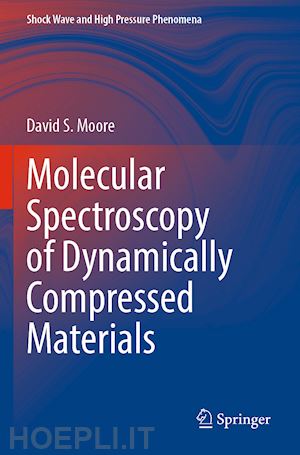
Questo prodotto usufruisce delle SPEDIZIONI GRATIS
selezionando l'opzione Corriere Veloce in fase di ordine.
Pagabile anche con Carta della cultura giovani e del merito, 18App Bonus Cultura e Carta del Docente
This book offers historical and state-of-the-art molecular spectroscopy methods and applications in dynamic compression science, aimed at the upcoming generation in physical sciences involved in studies of materials at extremes. It begins with addressing the motivation for probing shock compressed molecular materials with spectroscopy and then reviews historical developments and the basics of the various spectroscopic methods that have been utilized. Introductory chapters are devoted to fundamentals of molecular spectroscopy, overviews of dynamic compression technologies, and diagnostics used to quantify the shock compression state during spectroscopy experiments. Subsequent chapters describe all the molecular spectroscopic methods used in shock compression research to date, including theory, experimental details for application to shocked materials, and difficulties that can be encountered. Each of these chapters also includes a section comparing static compression results. The last chapter offers an outlook for the future, which leads the next-generation readers to tackling persistent problems.
David S. Moore is a retired Laboratory Fellow at the Los Alamos National Laboratory (LANL). His work mainly focuses on revolutionary approaches to study shocked materials and detect explosives using a wide variety of molecular spectroscopies. He received his Ph.D. from the University of Wisconsin–Madison in 1980 and was Director’s Postdoctoral Fellow at LANL 1980–1981. He has held a number of management positions at LANL, from Team Leader to acting Division Leader. He was Alexander von Humboldt Fellow at the University of Essen (1993–1994), and led the editorial office of the Fresenius Journal of Analytical Chemistry at Institut Fresenius, Germany (1996–1998). In 1998, he returned as R&D Scientist to LANL, where he established the ultrafast laser shock and diagnostics laboratory to study explosives initiation chemistry and the Los Alamos Collaboration for Explosives Detection. He has contributed to the Analytical Chemistry Division of the IUPAC and the APS Topical Group on Shock Compression of Condensed Matter for many years. He has also been honored with a number of awards and fellowships.











Il sito utilizza cookie ed altri strumenti di tracciamento che raccolgono informazioni dal dispositivo dell’utente. Oltre ai cookie tecnici ed analitici aggregati, strettamente necessari per il funzionamento di questo sito web, previo consenso dell’utente possono essere installati cookie di profilazione e marketing e cookie dei social media. Cliccando su “Accetto tutti i cookie” saranno attivate tutte le categorie di cookie. Per accettare solo deterninate categorie di cookie, cliccare invece su “Impostazioni cookie”. Chiudendo il banner o continuando a navigare saranno installati solo cookie tecnici. Per maggiori dettagli, consultare la Cookie Policy.